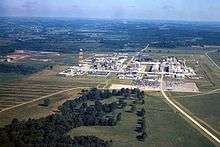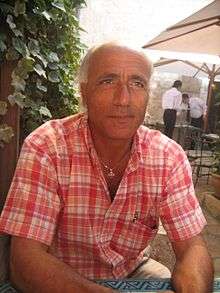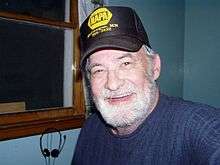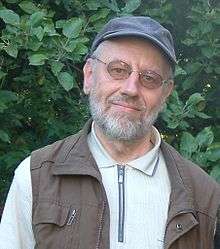List of nuclear whistleblowers

There have been a number of nuclear whistleblowers, often nuclear engineers, who have identified safety concerns about nuclear power and nuclear weapons production. In 1976 Gregory Minor, Richard Hubbard and Dale Bridenbaugh "blew the whistle" on safety problems at nuclear power plants in the United States. George Galatis was a senior nuclear engineer who reported safety problems at the Millstone 1 Nuclear Power Plant, relating to reactor refueling procedures, in 1996.[1] Other nuclear power whistleblowers include Arnold Gundersen and David Lochbaum.
Karen Silkwood
The first prominent nuclear whistleblower was Karen Silkwood, who worked as a chemical technician at a Kerr-McGee nuclear fuel plant. Silkwood became an activist in the Oil, Chemical and Atomic Workers International Union in order to protest health and safety issues. In 1974, she testified to the United States Atomic Energy Commission about her concerns.[2] A few months later she died in a car crash under mysterious conditions on the way to a meeting with a New York Times reporter and a national union leader.[3] The 1983 film Silkwood is an account of this story.
The "GE Three"
On February 2, 1976, Gregory C. Minor, Richard B. Hubbard, and Dale G. Bridenbaugh (known as the GE Three) "blew the whistle" on safety problems at nuclear power plants, and their action has been called "an exemplary instance of whistleblowing".[4]
The three engineers gained the attention of journalists and their disclosures about the threats of nuclear power had a significant impact. They timed their statements to coincide with their resignations from responsible positions in General Electric's nuclear energy division, and later established themselves as consultants on the nuclear power industry for state governments, federal agencies, and overseas governments. The consulting firm they formed, MHB Technical Associates, was technical advisor for the movie, "The China Syndrome." The three engineers participated in Congressional hearings which their disclosures precipitated.[5][6]

Browns Ferry nuclear power plant construction went underway in 1966. It was located in Alabama and in 1967 it earned a Federal construction permit. The plant received new design standards which call for “physical separation of electrical cables.” [7] There was an issue with the instructions on how to accomplish this so the AEC inspector F.U. Bower requested that the AEC elaborate; however, there was no response from the organization and installation went on. Still, no instructions were issued after five failed inspections in 1970. The lack of cable separation instructions led to the sacrifice of safety coolant systems in two of the units in order to improve one with severe safety violation. The ignorance of the AEC led to the fire that occurred on March 22, 1975, that almost led to a radiation leak. The substance separating the wires caught fire when tests to find air leaks with a candle ignited it thus resulting in damage to the control systems. With damage to the control systems, the cooling system that keeps the units from leaking radiation did not work properly. Somehow the situation was avoided and the units were put out of service. Throughout the occurrence of these events Bridenbaugh had been discussing his reservations on the safety at the plant in vain and in 1976 a year later Bridenbaugh, Hubbard and Minor resigned.
Crystal River 3 and Lou Putney
Lou Putney came on the scene of the Crystal River 3 plant after receiving a call from a plant engineer. The engineer claimed that the managers hired engineers based on "good ol' boy mentality."[8] The plant had experience numerous shut downs since 1978. Along with this concern, the engineer was not confident that the manager possessed the qualifications to be a manager. Although the engineer pursued nothing further with his complaint, it prompted Putney to purchase shares of stock in the company that would allow him to file "shareholder resolutions." Putney had looked into the nuclear reactors that were built of an unsafe material for emergency cooling procedures. The NRC had placed Crystal River on the top 14 worst reactors list because of this. So, the shares were purchased in 1981, which is when Putney filed his first shareholder resolution requesting the plant be shut down. This tradition was upheld by Putney for seven years until he was required to purchase more stock in order to continue filing resolutions. Over the course of sixteen years, Putney filed a total of fourteen shareholder resolutions. All of these resolutions were ignored and were met with offers to buy out his shares so he could no longer file the resolutions.[8] The plant was officially decommissioned in September 2009.
Ronald Goldstein
Ronald J. Goldstein was a supervisor employed by EBASCO, which was a major contractor for the construction of the South Texas plants. In the summer of 1985, Goldstein identified safety problems to SAFETEAM, an internal compliance program established by EBASCO and Houston Lighting, including noncompliance with safety procedures, the failure to issue safety compliance reports, and quality control violations affecting the safety of the plant.
SAFETEAM was promoted as an independent safe haven for employees to voice their safety concerns. The two companies did not inform their employees that they did not believe complaints reported to SAFETEAM had any legal protection. After he filed his report to SAFETEAM, Goldstein was fired. Subsequently, Golstein filed suit under federal nuclear whistleblower statutes.[9]
The U.S. Department of Labor ruled that his submissions to SAFETEAM were protected and his dismissal was invalid, a finding upheld by Labor Secretary Lynn Martin. The ruling was appealed and overturned by the Fifth Circuit Court of Appeals, which ruled that private programs offered no protection to whistleblowers. After Goldstein lost his case, Congress amended the federal nuclear whistleblower law to provide protection reports made to internal systems and prevent retaliation against whistleblowers.[10]
Fernald Nuclear Incidents

.jpg)
The Fernald Feed Materials Production Center was built in Crosby Township, Ohio in 1951, and decommissioned in 1989. Fernald processed uranium trioxide and uranium tetrafluoride, among other radioactive materials, to produce the uranium fuel cores for nuclear weapons. It was shrouded in suspicion with many manager changes and the people of the town ill-informed of the purpose of the plant.[11] The Fernald Feed Materials Production Center also conducted an evaluation of how much material was contaminated by Radium. Using 138 pieces of the CR-39 film assays, they were able to determine that people working in the area where K-65 silos ( Underground chamber used to store missiles) had lower levels of exposure of materials contaminated by Radon than the Q-11 silos between the period of 1952-1988 Journal of Exposure Science and Environmental Epidemiology.Throughout 1951-1995 the plant had numerous scandals including faking numbers for contamination and disregarding evidence of ground water pollution. Among the citizens affected by the pollution was Mrs. Lisa Crawford who took action. Crawford and other residents filed a lawsuit in 1985 and became president of the organization FRESH (Fernald Residents for Environmental Safety and Health).[12] A lawsuit was then filed once again against Fernald by former employees several years later in 1990. After several years of being heavily advised not to blow the whistle, the workers earned themselves a $15 million settlement and lifelong medical monitoring.[12] In 1992, FERMCO was hired to construct a cleanup plan for the plant and in 1996, around accusations of wasteful spending, the cleanup of ground water and soil was completed.[12]
Mordechai Vanunu

Mordechai Vanunu blew the whistle on the nuclear plant in Dimona, Israel in an interview with The Sunday Times that was published on the 5th of October, 1986. According to Vanunu, this plant had been producing nuclear weapons for 10 to 20 years.[13] It is estimated that there may be around 200 nuclear weapons in possession of Israel's nuclear weapons program.[14] Vanunu demonstrated his knowledge to Frank Barnaby and John Steinbach and they confirmed the credibility of his story. Frank Barnaby wrote in his Declaration of Frank Barnaby in the Matter of Mordechai Vanunu that Vanunu had the bare minimum knowledge of nuclear physics that a technician should have and accurately described the makeup of the nuclear plant in Dimona.[15] Vanunu has been in and out of jail after serving his 18 years issued by a closed door trial. Despite the whistle blown towards the operation of the nuclear weapons program in Israel, the Israeli government denied the existence of all allegations. [16]
Arnold Gundersen
In 1990 Arnold Gundersen discovered radioactive material in an accounting safe at Nuclear Energy Services in Danbury, Connecticut, the consulting firm where he held a $120,000-a-year job as senior vice-president.[17] Three weeks after he notified the company president of what he believed to be radiation safety violations, Gundersen was fired. According to the New York Times, for three years, Gundersen "was awakened by harassing phone calls in the middle of the night" and he "became concerned about his family's safety". Gundersen believes he was blacklisted, harassed and fired for doing what he thought was right.[17]
The New York Times reports that Gundersen's case is not uncommon, especially in the nuclear industry. Even though nuclear workers are encouraged to report potential safety hazards, those who do risk demotion and dismissal. Instead of correcting the problems, whistleblowers say, industry management and government agencies attack them as the cause of the problem. Driven out of their jobs and shunned by neighbors and co-workers, whistleblowers often turn to each other for support.[17]
The Whistleblower Support Fund is an organization that has compiled resources for whistleblowers to access if they are considering whistleblowing. It was founded by Donald Ray Soeken, who has counseled whistleblowers for 35 years. In addition, a social network to connect whistleblowers to other whistleblowers will be implemented. It will be a private discussion where whistleblowers can safely seek support.[18]
David Lochbaum
In the early 1990s, nuclear engineer David Lochbaum and a colleague, Don Prevatte, identified a safety problem in a plant where they were working, but were ignored when they raised the issue with the plant manager, the utility and the U.S. Nuclear Regulatory Commission (NRC).[19] After bringing their concerns to Congress, the problem was corrected not just at the original nuclear plant but at plants across the country.[20]
Gerald W. Brown

Gerald W. Brown was the whistleblower on the Thermo-Lag scandal, as well as on silicone foam firestop issues in the US and Canada, exposing the fact that fireproofing of wiring between control rooms and reactors did not function as intended and exposing bounding and combustibility issues with organic firestops.
George Galatis
George Galatis was a senior nuclear engineer and whistleblower who reported safety problems at the Millstone 1 Nuclear Power Plant, relating to reactor refueling procedures, in 1996.[1][21] The unsafe procedures meant that spent fuel rod pools at Unit 1 had the potential to boil, possibly releasing radioactive steam throughout the plant.[22] Galatis eventually took his concerns to the Nuclear Regulatory Commission, to find that they had "known about the unsafe procedures for years". As a result of going to the NRC, Galatis experienced "subtle forms of harassment, retaliation, and intimidation".[21]
Rainer Moormann

Rainer Moormann is a German chemist and nuclear power whistleblower. Since 1976 he has been working at the Forschungszentrum Jülich, doing research on safety problems with pebble bed reactors, fusion power and spallation neutron sources. In 2008 Moormann published a critical paper on the safety of pebble bed reactors,[23][24] which raised attention among specialists in the field, and managed to distribute it via the media, facing considerable opposition. For doing this despite the occupational disadvantages he had to accept as a consequence, Moormann was awarded the whistleblower award of the Federation of German Scientists (VDW)[25] and of the German section of the International Association of Lawyers Against Nuclear Arms (IALANA).
Setsuo Fujiwara
Setsuo Fujiwara, who used to design reactors, said he clashed with supervisors over an inspection audit he conducted in March 2009 at the Tomari nuclear plant in Japan. Fujiwara refused to approve a routine test by the plant's operator, Hokkaido Electric Power, saying the test was flawed. A week later, he was summoned by his supervisor, who ordered him to correct his written report to indicate that the test had been done properly. After Fujiwara refused, his employment contract was not renewed. "They told me my job was just to approve reactors, not to raise doubts about them", said Fujiwara, 62, who is now suing the nuclear safety organization to get rehired. In a written response to questions from The New York Times, the agency said it could not comment while the court case was under way.[26] Along with the lawsuit Mr. Fujiwara filed against the agency he used to work for, he had gone to the Tokyo District Court to further write several complaints about how the JNES ( Japan Nuclear Energy Safety Organization) failed to follow the UN laws concerning how to properly inspect nuclear energy reactors. Mr. Fujiwara also submitted several documents and emails that dealt with how the reactor inspections were improperly handled by JNES even though JNES denies all allegations. [42]
Walter Tamosaitis
The Hanford site resulted in a number of whistleblowers during the efforts to clean the site up. Walter Tamosaitis blew the whistle on the Energy Department’s plan for waste treatment at the Hanford site in 2011. Tamosaitis’s concern was the possibility of explosive hydrogen gas being built up inside tanks that the company was to store the harmful chemical sludge they were trying to put into hibernation for its chemical life. Shortly after this Tamosaitis was demoted and two years later, fired which triggered his lawsuit for wrongful termination. A $4.1 million settlement was offered to Tamosaitis from AECOM on the 12th of August 2015.[27] Tamosaitis has since been reinstated.
Donna Busche blew the whistle resulting in her 2013 lawsuit with claims that the URS “retaliated against her. [27] She was head of nuclear safety and a URS employee around the time when she expressed her concerns.[28][29]
Gary Brunson reported 34 safety and engineering violations after quitting in 2012. Brunson was federal engineering chief before he quit.[30]
Shelly Doss earned “$20,000 in emotional distress and $10,000 in callous disregard of her rights” as well as reinstatement in 2014. [27] Doss was an environmental specialist at the time of her firing in 2011 working for Washington River Protection Solutions.
Larry Criscione and Richard H. Perkins
In 2012, Larry Criscione and Richard H. Perkins publicly accused the US Nuclear Regulatory Commission of downplaying flood risks for nuclear plants which are sited on waterways downstream from large reservoirs and dams. They are engineers with over 20 years of combined government and military service who work for the NRC. Other nuclear safety advocates have supported their complaints.[31]
John Pace and Dan Parks
In 1959, John Pace was employed at the Santa Susana Field Lab, 36 miles from Los Angeles, at the time of the partial meltdown during the Sodium Reactor Experiment. According to Pace, the reactor building doors and reactor exhaust stack were opened, releasing radiation into the atmosphere. Dan Parks also worked at the Santa Susana Field Lab, as a health physicist in the 1960s, where he witnessed the burning of radioactive waste in burn pits, and frequently saw workers illegally vent radiation into the atmosphere. In 2015 they spoke out about the incident in an investigative report by NBC News.[32][33]
Other nuclear whistleblowers
- Chuck Atkinson[34]
- Dale G. Bridenbaugh
- Joe Carson [35]
- Larry Criscione[36]
- Mark Gillespie[37]
- Lars-Olov Höglund[38]
- Carl Hocevar[39]
- David Hoffman[40]
- Avon Hudson
- Rainer Moormann
- Carl Patrickson[41]
- Richard H. Perkins[36]
- Robert Pollard[39]
- John P. Shannon[42]
- Don Ranft[43]
See also
References
- 1 2 Eric Pooley. Nuclear Warriors Time Magazine, March 4, 1996.
- ↑ Rashke, Richard L. (1981). The Killing of Karen Silkwood: The Story Behind the Kerr-McGee Plutonium Case. Houghton Mifflin Company. ISBN 978-0801486678.
- ↑ Tolley, Laura (April 24, 1994). "Karen Silkwood Case Returns to Haunt Parents : Whistle-blower: The disclosure that Los Alamos lab has had her bone fragments since 1974 outrages family. A worker in a plutonium-processing plant, she died in a car crash while on her way to meet a reporter. She had promised to bring proof the plant was unsafe; no documents were in the car.". Los Angeles Times. Associated Press. Retrieved 18 September 2016.
- ↑ Whistleblower on Nuclear Plant Safety
- ↑ "Environment: The San Jose Three". 16 February 1976. Retrieved 15 June 2015.
- ↑ "Environment: The Struggle over Nuclear Power". TIME.com. 8 March 1976. Retrieved 15 June 2015.
- ↑ Weil, Vivian. "Moral Responsibility and Whistleblowing in the Nuclear Industry: Browns Ferry and Three Mile Island." (1983).
- 1 2 Riggs, Stephanie. "FLORIDA POWER AND THE CRYSTAL RIVER NUCLEAR POWER PLANT." (1997).
- ↑ Zuniga, Sonia (April 26, 2016). "20 memorable whistleblowers in the U.S.". Houston Chronicle. Retrieved 18 September 2016.
- ↑ Kohn, Stephen Martin (2011). The Whistleblower's Handbook: A Step-by-Step Guide to Doing What's Right and Protecting Yourself. Guilford, CT: Globe Pequot Press. pp. 116–18. ISBN 9780762774791.
- ↑ Bonfield, Tim (February 11, 1996). "History repeats itself". The Cincinnati Enquirer. Retrieved 18 September 2016.
- 1 2 3 "The Enquirer's Fernald Investigation". enquirer.com. Retrieved 2016-06-27.
- ↑ http://www.jstor.org/stable/2536653
- ↑ The Emirates Center for Strategic Studies and Research (2009). Nuclear Energy in the Gulf. I. B.Tauris & Company, Limited. p. 336. ISBN 9789948141174.
- ↑ Barnaby, Frank (14 June 2004). "Expert Opinion Of Charles Frank Barnaby in The Matter of Mordechai Vanunu" (PDF). fas. Retrieved 21 June 2016.
- ↑ http://search.proquest.com/docview/1714013298
- 1 2 3 Julie Miller (February 12, 1995). "Paying The Price For Blowing The Whistle". The New York Times.
- ↑ "Whistleblower Support Fund". Whistleblower Support Fund. Retrieved 2016-06-13.
- ↑ Heidorn Jr., Rich (January 31, 1999). "Whistle-blower Tells Of Nuclear-plant Fears He Disagreed With Bosses Over Safety Issues In Allentown And Was Fired. Osha Sided With Him.". The Philadelphia Inquirer. Retrieved 18 September 2016.
- ↑ Kyle Rabin (2011-06-30). "Our Hero: David Lochbaum of the Union of Concerned Scientists". Ecocentric.
- 1 2 William H. Shaw. Business Ethics 2004, pp. 267-268.
- ↑ Adam Bowles. A Cry in the Nuclear Wilderness Christianity Today, October 2, 2000.
- ↑ "JuSER" (PDF). Retrieved 15 June 2015.
- ↑ "JuSER" (PDF). Retrieved 15 June 2015.
- ↑ Press statement of the VWD (in German), official short version in English: http://ialana.net/uploads/media/Program_Whistleblower_Award_2011.pdf, inofficial English translation of the press release: https://euzicasa.wordpress.com/2011/06/10/presentation-of-whistleblower-award-2011_via-hintergrund/
- ↑ "Warnings on Fukushima ignored, insiders say; They attribute failure to cozy ties between government and industry". Power Engineering. March 11, 2012.
- 1 2 3 Times, Los Angeles. "Hanford nuclear weapons site whistle-blower wins $4.1-million settlement". latimes.com. Retrieved 2016-06-28.
- ↑ CBS News (February 19, 2014). "Second whistleblower Donna Busche fired at troubled Wash. State Hanford nuke plant". CBS This Morning. Retrieved 18 September 2016.
- ↑ Winograd, David (February 18, 2014). "Whistleblower Fired After Raising Safety Concerns at Federal Nuclear Site". TIME. Retrieved 18 September 2016.
- ↑ LaFlure, Rebecca (November 19, 2013). "Hanford nuclear site clean-up: The mess gets worse". NBC News. Retrieved 18 September 2016.
- ↑ Tom Zeller Jr. (April 4, 2012). "Nuclear Power Whistleblowers Charge Federal Regulators With Favoring Secrecy Over Safety". Huff Post Green.
- ↑ Grover, Joel; Glasser, Matthew. "L.A.'s Nuclear Secret". NBC. National Broadcasting Network. Retrieved 31 October 2016.
- ↑ Grover, Joel; Glasser, Matthew (2015). "L.A.'s Nuclear Secret: Part 1". NBC News - Investigative Team. National Broadcasting Company. Retrieved 31 October 2016.
- ↑ Whistleblowing and nonviolence
- ↑ "DOE from the Perspective of a DOE Safety Employee (Whistle-blower Joe Carson addresses a meeting of sick USEC Paducah workers)". October 31, 2011. Retrieved 22 September 2013.
- 1 2 Tom Zeller Jr. (12/04/2012). "Nuclear Power Whistleblowers Charge Federal Regulators With Favoring Secrecy Over Safety". Huff Post Green. Check date values in:
|date=(help) - ↑ Seabrook Whistleblower Says Power Plant Unsafe
- ↑ Former Safety Chief Blows Whistle on Poor Safety Culture
- 1 2 Falk, Jim (1982). Gobal Fission:The Battle Over Nuclear Power, p. 95.
- ↑ Court papers: Nuclear feud at Fla. plant
- ↑ Nuke Watchdog Urges New Look at Whistleblower Case
- ↑ "Corruption at the Knolls Atomic Power Laboratory...". December 21, 2001. Retrieved 14 September 2013.
- ↑ Heidorn, Rich. "Whistle-blower Tells Of Nuclear-plant Fears He Disagreed With Bosses Over Safety Issues In Allentown And Was Fired. Osha Sided With Him". philly.com. Philadelphia Inquirer: Collections • OSHA. Retrieved 18 September 2016.
External links
- Watching the Watchdogs
- A Nuclear Plant Gets New Equipment and a New Attitude
- Government Accountability Project Whistleblower protection Org.
- Ed Yong (28 November 2013). "3 ways to blow the whistle" (PDF). Nature (journal) Vol 503.
- National Whistleblowers Center - Nuclear Whistleblowers
- ↑ "Estimation of radon exposures to workers at the Fernald Feed Materials Production Center 1952-1988". Journal of Exposure Science and Environmental Epidemiology. 18.
- ↑ Hayashi, Yuka. 2011. " World News: Japan: Ex-Inspector Complains of Regulators' Practices." The Wall Street Journal Asia, Jun 16